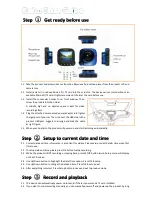
. . . . . . . . . . . . . . . . . . . . . . . . . . . . .
5-8
Using the Camera
G
Turning Off the Camera
You turn off the camera by sliding the power switch to off (O).
When the camera is on but not awake (the LCD on the camera back is
off), the drain on the battery is very minimal as the camera system waits in
a sleep state for your next action. Therefore, in normal usage of the
camera during a shooting session with or without the AC battery charger/
adapter, it is not necessary to continually turn the camera off then on
again. In either case, when you are finished with a shooting session, you
should turn off the camera by sliding the power switch to off (O).
Taking Pictures
1. Turn on the camera system, and wake it by lightly pressing the shutter
release button.
2. Frame the scene within the inner rectangle of the focusing screen. The
focusing screen in the camera has been modified and indicates a
reduced view of the scene to match the size of the picture that will be
recorded on the imager. (An illustration of the focusing screen appears
in the Specifications appendix.)
3. Focus.
You can use manual focus, or select any of the focusing points, or let
the camera select the focusing point. (Please refer to information in
the supplied EOS-1 N Instructions for a detailed explanation of
focusing point selection and choice of AF mode.)
Placing the camera into F-11-1 custom function mode as described
earlier in this chapter, alters the process you use for selecting a
focusing point. The new procedure is different from the process you
would follow if the Canon EOS-1 N were being used without the
















































